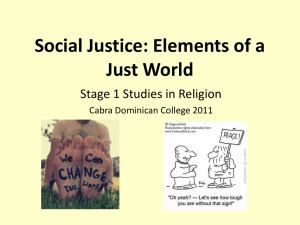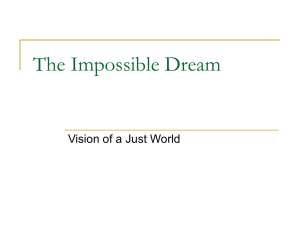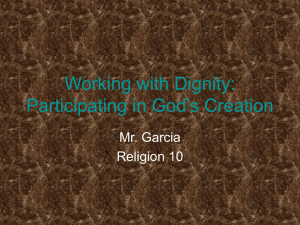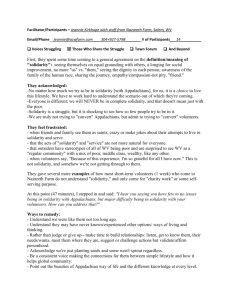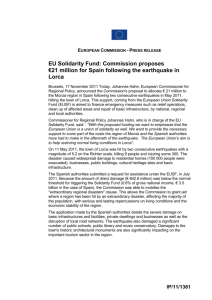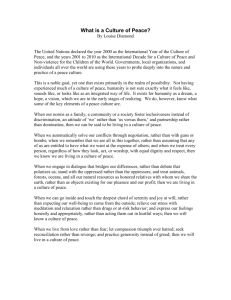education for peace - The International Peace Foundation
advertisement
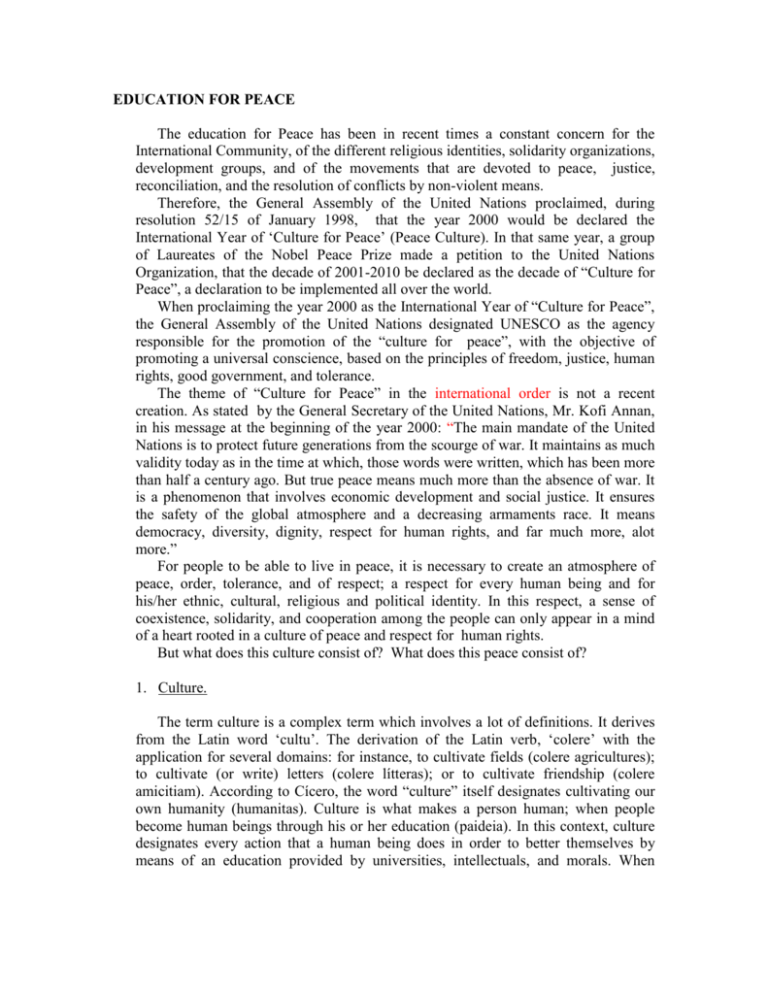
EDUCATION FOR PEACE The education for Peace has been in recent times a constant concern for the International Community, of the different religious identities, solidarity organizations, development groups, and of the movements that are devoted to peace, justice, reconciliation, and the resolution of conflicts by non-violent means. Therefore, the General Assembly of the United Nations proclaimed, during resolution 52/15 of January 1998, that the year 2000 would be declared the International Year of ‘Culture for Peace’ (Peace Culture). In that same year, a group of Laureates of the Nobel Peace Prize made a petition to the United Nations Organization, that the decade of 2001-2010 be declared as the decade of “Culture for Peace”, a declaration to be implemented all over the world. When proclaiming the year 2000 as the International Year of “Culture for Peace”, the General Assembly of the United Nations designated UNESCO as the agency responsible for the promotion of the “culture for peace”, with the objective of promoting a universal conscience, based on the principles of freedom, justice, human rights, good government, and tolerance. The theme of “Culture for Peace” in the international order is not a recent creation. As stated by the General Secretary of the United Nations, Mr. Kofi Annan, in his message at the beginning of the year 2000: “The main mandate of the United Nations is to protect future generations from the scourge of war. It maintains as much validity today as in the time at which, those words were written, which has been more than half a century ago. But true peace means much more than the absence of war. It is a phenomenon that involves economic development and social justice. It ensures the safety of the global atmosphere and a decreasing armaments race. It means democracy, diversity, dignity, respect for human rights, and far much more, alot more.” For people to be able to live in peace, it is necessary to create an atmosphere of peace, order, tolerance, and of respect; a respect for every human being and for his/her ethnic, cultural, religious and political identity. In this respect, a sense of coexistence, solidarity, and cooperation among the people can only appear in a mind of a heart rooted in a culture of peace and respect for human rights. But what does this culture consist of? What does this peace consist of? 1. Culture. The term culture is a complex term which involves a lot of definitions. It derives from the Latin word ‘cultu’. The derivation of the Latin verb, ‘colere’ with the application for several domains: for instance, to cultivate fields (colere agricultures); to cultivate (or write) letters (colere lítteras); or to cultivate friendship (colere amicitiam). According to Cícero, the word “culture” itself designates cultivating our own humanity (humanitas). Culture is what makes a person human; when people become human beings through his or her education (paideia). In this context, culture designates every action that a human being does in order to better themselves by means of an education provided by universities, intellectuals, and morals. When humanity educates themselves through these domains, they in turn can educate others towards a culture of peace. For the Catholic Church, this "Culture of Peace" indicates all of the things through which human beings thicken and develop multiple capacities of his/her spirit and body. He or she makes an effort to accomplish, through study and work, the betterment of their own world and its institutions which will meet the needs of the civil community. With the passing of time, their experience and aspirations will become a benefit to humanity as a whole" (GS, n-53). These individuals exist in several cultures around the world, working and succeeding through different means to establish habits, religion, laws, judicial institutions, science, the arts, and the cultivation of beauty. Not only do several cultures exist, they have spread throughout the word due to the progress of not only natural science, but also human and social science through improved means of international communication and coordination. In this era of globalization, despite the existence of regional and national cultures, there exists a universal culture of humanity; a culture which understands and expresses the unity of mankind, and best knows how to respect the peculiarities and traditions of its many different cultures. It is in this context of a universal human culture in a globalized world, that we should build a more peaceful and fraternal society through the practice of peace and justice. Despite the yearning for constructing a more loving and understanding world, there are those who try to create a culture of hate, violence, and war. Because of this fact, much of mankind is left to be tormented by hunger, poverty, and illiteracy. Many men and women today live in social and psychological servitude. Political, social, economic, racial, and ideoligical conflict still persist. War has not been totally eliminated. As has been stated to the Council Vatican II: "Great discrepancies appear between the races and several social groups among nations, rich and poor derived from the ambitions of those who wish to spread their own ideologies along with the collective selfishness of certain individuals in power. From this comes distrust and hatred which lead to conflicts of which innocent human beings are the unfortunate victims"(GS, n. 8). We know that the 20th century was the century of two world wars: World War I (1914-1918) and World War II (1939-1945). There were also countless other conflicts in Asia The Korean War, The Vietnam War, violence between India and Pakistan; the Middle East: between Israel and the Arab Countries, in Iraq and Afghanistan; conflicts between natives and their colonizers: France and Algeria; Portugal and her colonies of Africa (Angola, Mozambique and Guiné Bissau); between different ethnic and religious groups: the conflict between Indonesia and Timor-east; the war in Spain; the conflict among Protestants and Catholic in Ireland, wars in Burundi, Rwanda; Liberia, Sudan, Eritréia, and in the former Yugolslavia. The 20th century was also the cold war period which produced the most astounding armament race consisting with the proliferation of nuclear weapons. It was the century that deepened divisions between the rich and poor nations, developed and underdeveloped, North and South, West and East, First world and Third world, Christian and Islam, Hinduism and Islam, Catholics and Protestants, capitalists and communists. According to a study in 2000 by the Annual of the Institute of Peace Investigation in Stockholm (SIPPRI), 27 armed conflicts of great scale occurred in 1999 alone. These were conflicts which were between the armed forces of two or more governments, or between a government and rebel groups, and which were each responsible for the death of at least 1000 individuals through one year of violence. Behind these numerous conflicts that threaten peace, there exists other deeper factors that can create the seeds of hatred which lead to violence: the nuclear proliferation; the confrontation among world power blocks, mainly West and East; the unbalance of world power between the Northern and Southern Hemisphere: the nations in the Northern Hemisphere, rich and developed, which enjoys economic, social, and cultural well-being co-existing with the nations in the Southern Hemisphere, poor and underdeveloped, where legions of the impoverished, unemployed, desperate, and destitute exist and who can easily be recruited by multinational corporate thieves, religious fanatics, and terrorists. Even in the Northern Hemisphere, there exists great poverty and desperation that arises from the “slums” of the great urban centers of the world; areas which also produce a fair amount of the world’s environmental problems through pollution and the exhaustion of natural resources: all current problems which test the presence of international peace There exists the great “international Mafia” of influential individuals who, through private armies, dominate drug cartels, the extraction and illegal trade of raw materials, the clandestine emigration of weapons and of people, the smuggling and laundering of money, all of which constitutes a danger for the stability and the safety of the world and its people. In spite of these unfortunate realities, we cannot fall into discouragement and leave the world alone to face extermination. On the contrary, we have to row against the current, falling back upon the weapons of understanding, solidarity and collective responsibility, infecting the world with a new mentality, of love, compassion, and peace by developing this new “Culture”. The old director - general of UNESCO, Dr. Frederico Mayor Zamora, had this happy intuition: " For us to transform a war culture into a peace culture, we have to change the values, the attitudes, and the behaviors of the past. Instead of using the Roman maxim: "if you want peace, you must prepare for war" – we have to proclaim: “If you want peace, you must prepare for peace, and try to build it in your everyday life." However, for the people to create and possess a peace culture, it is essential that they be educated for the attainment of peace and human rights 2. What is Peace The English word “peace”, the French word “paix”, the Italian word “pace”, the Portuguese and Spanish word “paz”, are all derived from the Latin word of “'pax or pacis”. According to a great number of historians, the concept of the 'Pax' was born in the Roman Empire. It indicated a time when “there was no wars or civil conflicts” It was more rightly labelled: "Pax Romana". Linked to the concept of 'pax', the Romans cultivated other abstract concepts of Concordance, Honor, Virtue, etc. Santo Agostinho, a Catholic Bishop of the 4th Century, defined 'Paz' as the “peacefulness of the order”. In the Judeo-Christian context, the corresponding word in Hebrew was 'Shalom', a word that flows from the root 'shelemut'. It means perfection and fullness. In the Bible, Shalom appears associated with a state of harmony, peacefulness and prosperity. Shalom also means blessing, manifestation of the divine, grace, justice, truth, happiness, and well-being. According to the Prophet Isaiah, peace is “the fruit of justice” (Is.32,17); “ God is the Prince of Peace” (Is.9,5). For Christians (Catholic) “true peace is in Jesus Christ” (cf. Ef.2,14); it is “the fruit of the Holy Spirit” (Gal.5,22-23). after His resurrection, Jesus had said: “Peace be with you" (Jo.21,21). It is Him who gives us peace: " I leave you peace, I give you my peace” (Jô. 14,27). In the context of Christian spirituality, spiritual theology distinguishes between individual or internal peace and social or external peace. Individual peace is the peacefulness originating from a spiritual domain derived from internal passion and consciousness of being in communion of friendship with God and with others. Social peace is a calm coexistence in the social order. It is in this sense that the Catholic Church affirms that this peace is not merely the absence of war, nor is it merely the balance of established relations between adverse forces (cfr. GS., n.78). According to the teaching of the Catholic Church, to build this social peace, it is very necessary to have the will to respect the dignity of others, and necessary to implement the practice of fraternity. According to Pope Paul VI (1963-1978) “peace” is “development”. In this perspective, peace means the eradication of injustices and inequalities of the social and economic order, eradication of jelousies, and of the distrust and pride that is propagated between nations, which remain a constant threat to peace. For people to live in the same conditions, it is vital that the international community provides to each individual the essential social needs such as food, education, healthcare, and employment, which presently exists in developed countries and is denied to underdeveloped countries, by coming to the aid of the world’s impoverished refugees and immigrants alike along with their families"(GS, n. 85). Pope John XIII, in the Encyclical Pacem in Terris declares: "Mutual international relationships, like individual relationships, should not be constructed by force or violence, but by reason. That is the base of truth, justice, and of active solidarity. Relationships among nations should be based on this principle. Truth demands that all types of racism be eliminated, creating a new beginning where the dignity of each individual is recognized. Each person, therefore, has a right to existence; to the ownership of the necessary resources which will eradicate his material dependence on others. Nations can differentiate their own cultures, civilization, and economic development. This, however, can never justify the tendency of one to impose their believed superiority wrongly on the masses"(PinT, n.34). b) International relationships in the base of justice means that States should recognize the mutual rights of each other and in turn cooperate fairly in world development. States are entitled to existence, to development and the supply of necessary resources for achieving it (Ib, n. 35). C) in the base of active solidarity. Derived from truth and justice, nations develop international relationships in a dynamic of social solidarity, politics, culture, and in turn, offer us a real view of the world.”(cf. Ib. N. 37). On the other hand, the respect and the growth of human life demands peace (cf. CIC, n. 2304). Peace is not possible on the Earth without the safeguarding of people's goods, the free communication among human beings, and the respect for people's dignity and the assiduous practice of fraternity. In view of these beliefs, all wars should be eliminated or avoided. The employment of nuclear weapons, the use of insidious, terrorist, and subversive methods, or of blackmail should be combatted. The acts of exterminating entire races, nations, or ethnic groups should be condemned and considered as crimes against the humanity, the perpetrators being the leaders and warlords that authorize their execution. The warlike actions of destructing of whole cities or vast areas and the indiscriminate murder of their inhabitants is a crime against God and mankind itself (cfr. GS, n.8). 3. EDUCATION FOR PEACE The education for peace is an education that should show another vision contrasted to war, striving to avoid the formation of the social assumption that war is normal and inevitable, and construct the belief that there are non violent ways to resolve conflict. Article 26 of the Universal Declaration of the Human Rights establishes: " First, all people are entitled to education. The education should be free, at least in respect to its elementary and fundamental teachings. The elementary teaching is obligatory. The technical and professional teaching should be generalized. Access to superior studies should be open to all, possessing equal opportunities for each skill level. Second, education should seek to fully express the human personality and the reinforcement of man's rights and fundamental freedoms, and it should favor understanding, tolerance, and friendship among all nations, racial and religious groups, and the development of the activities of the United Nations for the maintenance of peace. However, the education for peace and for human rights seeks everyone. Its aim, is not so much to reach literary or scientific objectives, but to form the whole human individual in the values of ethics and citizenship. It should have an underlying educational aim to an ideal of society, as a starting point and as a goal to reach. We believe that the aim of a serious educational system of ethical values, could be directed towards an ideal for a personalized, democratic, participatory, solitary, and decentralized society. The education for peace should be an effort to consolidate a new way to see, to understand, and to live in the world, beginning with ourselves and eventually others, horizontally, forming a net, giving trust, safety and authority to the people and the societies, making exchanges, overcoming the distrusts, helping to mobilize and to overcome the differences among us. 3.1. The recommendations of UNESCO: In 1974, the General Conference of UNESCO produced the Recommendation concerning the education for the understanding of man's rights and fundamental freedoms (General Conference of the Organization of the United Nations for the Education. The Science and the Culture, Paris, October 17 on November 23, 1974). In recommendation 33, it made reference to the importance of the States-members in the educators' preparation: a) States should develop in the educators the motivations of his/her actions, adhesion to the ethics of the man's rights and the objective of changing the society... b) to offer interdisciplinary knowledge on the world problems and the problems of international cooperation, namely through a relative workshop directed to the solution of those problems. In that conference, it also proceeded to the clarification of concepts in relation to used terms and they defined the beginning politics of education. In relation to the significance of the terms, the words "education", "understanding", " cooperation" and "peace", the man's" "rights and the "fundamental freedoms", the following can be noted: The word 'education” designates the global process of society for which the people and the social groups learn consciously, inside the national and international community and in benefit of this, produce the integral development of their personalities, of their capacities, of their attitudes, of their aptitudes, and of their knowledge. The terms 'understanding', 'cooperation' and 'peace' should be considered as all indivisible, founded in the beginnings of the friendly relationships between people and States with social and political systems different and in the respect of the man's rights and of the fundamental freedoms. In the text of the present Recommendation, the several connotations of these terms are, per times, in brief, 'education of international vocation' (p.54) Finally, in the perspective of the Conference, the objectives that should be considered as 'starting points' for the politics of the education of any State: a. An international dimension and a world perspective of education, all levels and forms b. the understanding and the respect of all people, of their civilizations, of their values and of their traditions, including the cultures of the national minority and of other nations; c. the consciousness of the growing world interdependence on people; d. the capacity to communicate with others and the consciousness not only of the rights, but also of the duties that the individuals, the social groups and the nations have to others; f. the understanding of the need for solidarity and international cooperation; g. the will, in individuals, of contributing to solve their own communities' problems, of their countries’ and of the worlds"(p.54). 3.2. Areas of education for Peace: Peace's culture implicates for education in these possible areas: the education of democratic citizenship; human rights; democracy and tolerance; economic development and social maintainability; peace and international safety; participatory communication and free circulation of information and knowledge; ethical values; practice of the virtues of justice, solidarity, and generosity. Other extents of education can be those that were declared in the Manifesto of several Laureates of the Nobel Peace Prize, in the year 2000: To respect life; to reject violence; to share with others; to listen; to understand; to conserve the planet; and to rediscover solidarity. 3.3. Methodology for Education for Peace: The methods in the education for Peace have been coherent with the contents and values that it intends. Having been horizontal, that is, open to participative dialogues that encourage solidarity and cooperation. The programs should be elaborated in a way that motivate people to learn and reflect about social realities, politics, cultural, and economics in an open, sincere, and permanent dialogue in order to learn, discern, and to combat all forms of discrimination in schools, in families, in nations, and in the world. 3.4. The involvement of all the components of the society for a global education for Peace: The education for Peace and for a peace Culture in the world today, should include all of the citizens of the world: individuals, families, schools, universities, , religions and states: a.) Individual: to educate and to form for solidarity; to respect men and womens’ rights; to work for the peace: peace in the family, in society, peace with God, and peace with the environment b.) Family: the parents educate the children in ethical values c.) Schools, Universities and other educational institutions: they are spaces of inclusive education and of social intervention that can infuse in the students and graduates an integral formation for democratic citizenship. d.) Religions and Churches: they have the responsibility of educating humanity for the sense of the Absolute, for dialogue, tolerance, fraternity, peace and harmony. Religion is only authentic when it divulges the respect for life, for human beings’ dignity and the dignity of created things. As for the Catholic Church, it should be willing to collaborate with all religions and with all individuals willingly to serve the whole human family, in a base of frank dialogue, in mutual respect, and in concordance. e.) States: States have the duty and the responsibility of defending democratic values, of good government, and of transparency in the public business sector. States have the duty of promoting the democratization of education and other conditions so that education, accomplished through the school, the University, and of other formative ways, contribute to the equality of opportunities, the eradication of economic, social, and cultural inequalities, the development of personality and spirit of tolerance, of mutual understanding, of solidarity and of responsibility for the social progress and for the democratic participation in the collective society. f.) International level: - The multilateral organisms should guarantee the protection of human rights, the protection of minorities, the prevention of armed conflicts, and environmental protection. g.). Construction of the International Community: To build the peace and to make possible a Culture of Peace in the world, all people should make the great effort of creating an international organism capable of repressing violence and cooperating in the equal progress of all people. There are praiseworthy institutions already existing that work for peace in the world. In this sense, we ask that the Organization of the United Nations is improved in order to serve all Humanity better. Conclusion: The education for Peace is an education for global citizenship, and this implicates to favor the understanding of global interdependence and the need to bridge the structural divisions between rich and poor, the developed "North" and the underdeveloped "South"; between the West and the East; between Christianity and Islam, or Islam and Hinduism. To overcome these differences and the distrust that still reigns in the world, the program of Peace’s Culture in the World, and the Education for Peace and for Human Rights, can contribute to Humanity's ethical renewal in this globalized world. Maputo, July of 2004. Msrg. Carlos Filipe Belol Ximenes Titular Bishop of Lorium and Nobel Peace Price 1996.
